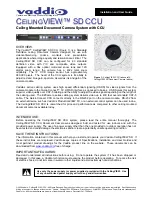
■
Mounting the devices on conductive metal surfaces.
■
Correctly grounding the devices and metal surfaces in the system.
■
If necessary: low-impedance and current-carrying equipotential bonding between
areas with different ground potentials
If these conditions are not fulfilled, equipotential bonding currents can flow along the
cable shielding between the devices due to differing ground potentials and cause the
hazards specified. This is, for example, possible in cases where there are devices within
a widely distributed system covering several buildings.
Remedial measures
The most common solution to prevent equipotential bonding currents on cable shields
is to ensure low-impedance and current-carrying equipotential bonding. If this equipo‐
tential bonding is not possible, the following solution approaches serve as a suggestion.
NOTICE
We expressly advise against opening up the cable shields. This would mean that the
EMC limit values can no longer be complied with and that the safe operation of the
device data interfaces can no longer be guaranteed.
Measures for widely distributed system installations
On widely distributed system installations with correspondingly large potential differ‐
ences, the setting up of local islands and connecting them using commercially available
electro-optical signal isolators
is recommended. This measure achieves a high degree
of resistance to electromagnetic interference.
The use of electro-optical signal isolators between the islands isolates the ground loop.
Within the islands, a stable equipotential bonding prevents equalizing currents on the
cable shields.
6.2
Wiring instructions
NOTE
Pre-assembled cables can be found online at:
•
•
NOTICE
Faults during operation and device or system defects!
Incorrect wiring may result in operational faults and defects.
■
Follow the wiring notes precisely.
All electrical connections of the device are configured as M12 round connectors.
The protection class stated in the technical data is achieved only with screwed plug
connectors or protective caps.
Configure the circuits connected to the device as ES1 circuits or as SELV circuits (SELV
= Safety Extra Low Voltage). The voltage source must meet the requirements of ES1
and PS2 (EN 62368-1) or SELV and LPS (EN 60950-1).
Protect the device with an external slow-blow fuse at the beginning of the supply cable.
The required fuse rating is 10 A slow-blow.
Connect the connecting cables in a de-energized state. Do not switch on the supply volt‐
age until installation is complete and all connection work on the device and controller
has been finished.
6
ELECTRICAL INSTALLATION
22
T E C H N I C A L I N F O R M A T I O N | Camera ICD880/890 Generation 4
8023775/1A4I/2020-12-01 | SICK
Subject to change without notice
















































